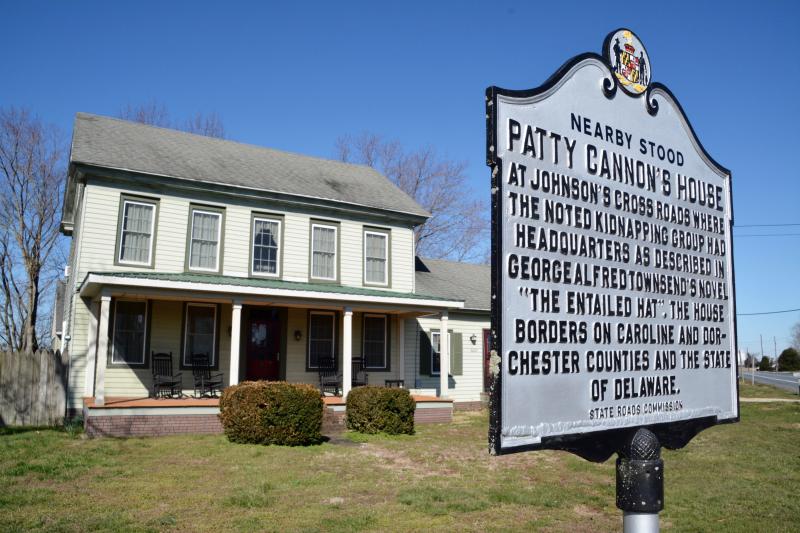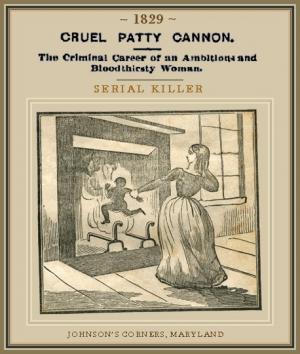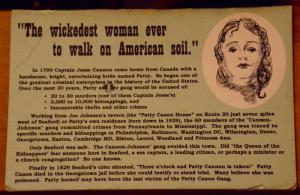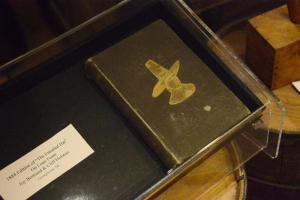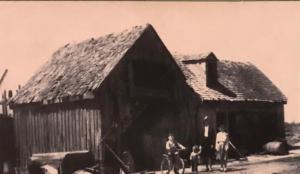A Sussex County serial killer
Able to elude capture for years, this notorious criminal was one of the nation's first female serial killers. Patty Cannon, who lived on the Delaware-Maryland line near Seaford, confessed to killing more than two dozen people – including her husband and one of her children.
It's even reported she threw one child in a fire to stop her from crying.
Her gang of 50 to 60 people operated for 30 years, committing as many as 30 murders and more than 3,000 kidnappings, countless thefts and other crimes.
Patty, aka Lucretia or Martha, Cannon and her Cannon-Johnson gang kidnapped free African-Americans and runaway slaves in the early 19th century and sold them back into slavery in the South. Cannon was indicted for murder in 1829 when the remains of three children were found by a tenant farmer on a property she owned in Sussex County.
Adding to the legend, she did not hang for her deeds but died mysteriously in jail, probably from poison. Incredibly, local historians may have found a living southern connection in her family tree.
The gang operated from a house in Reliance, Md., about five miles west of Seaford. Because the house was located near the convergence of Sussex County in Delaware and Caroline and Dorchester counties in Maryland, she moved from county to county and state to state to escape the law.
Her gang was so infamous they became known as the Reverse Underground Railroad. The gang was tied to murders and kidnappings in big cities and small towns including Philadelphia, Baltimore, Washington, D.C., and Dover, Georgetown, Laurel and Woodland in Delaware and Easton, Cambridge, Elkton and Princess Anne in Maryland.
For unknown reasons, her gang was never tied to any crimes in nearby Seaford.
Cannon married Jesse Cannon and had two children. After her husband died, she and her son-in-law, Joe Johnson, built a tavern on the Delaware-Maryland state line, which became the base for the gang's operations.
Dan Parsons, Sussex County's historic preservation planner, has been researching Cannon in order to file an application with the National Park Service to establish an official historic site where her house was located.
Parsons said he uncovered an 1808 deed in Sussex County records proving that Jesse and Patty Cannon owned the land where the tavern and house were located.
Devil on the Nanticoke
Author Mike Morgan, who wrote “Delmarva's Patty Cannon: Devil on the Nanticoke,” said while the gang kidnapped runaway slaves, they preyed on free African-Americans living in Philadelphia and Baltimore.
“They would lure them by offering money to help unload a boat. Once they got them on the boat, they would put them in chains and sail back to the Seaford area on the Nanticoke River where they would unload them. When slave traders would come by, they were sold and shipped south,” Morgan said.
So why? “Who knows why someone turns to a life of crime,” Morgan said. “But this was a lot of money, and for the most part easy money.”
He said slaves could be sold for $200 to $300, which would be thousands in today's money.
Morgan said, although he was at first skeptical that he could confirm facts about her life, he was able to discover contemporary documents verifying many of her notorious deeds.
“After research, I could document most of her life. Whatever you have had heard about her is probably true, and even more so,” he said.
A key piece of evidence was a newspaper article written in 1829 around the time of her arrest and death. “It really summed up her career before the legend had time to grow,” he said.
Another key piece of evidence was an 1841 publication in New York called the “Narrative and Confession of Lucretia Cannon.”
Morgan said the detailed story was written about 20 years after she died although an author's name is not attached to it. However, he said, he was able to verify nearly every detail through other sources.
He also uncovered an entry in the diary of Daniel Rodney of Lewes who sent a company of soldiers to Georgetown for crowd control during the trial and hanging of two of Cannon's associates, Henry Brereton and Joseph Griffith, about a decade before Cannon was arrested.
Rodney (1764-1846) is one of Sussex County's most famous people serving as governor as well as U.S. representative and senator.
Poison before hanging
Born around 1760, there are no records of Cannon’s infamous deeds until around 1802. It's then she, and a band of relatives and hired African-American decoys, tricked and trapped unfortunate African Americans who crossed the gang's path.
Cannon and her gang kept their prisoners chained and hidden in the basement, attic and secret rooms in their house. She used the nearby Nanticoke River – and probably the Cannon (now Woodland) Ferry – to transport those she had captured to the Chesapeake Bay and then down the coast back to southern states.
Cannon was arrested in April 1829 by the Dorchester County sheriff at the tavern where he found 21 people in chains ready for transport to the South. Cannon was handed over to the Sussex County sheriff and transported to Seaford by a mounted posse where she was taken to Magistrate Dr. John Gibbons from Lewes. She was then taken to the Georgetown jail to stand trial.
One member of the gang was convinced to turn state's evidence and reveal the murderous deeds of Cannon and her gang.
Her imprisonment didn't last long. On May 11, she was found dead in her cell. Speculation is that she committed suicide by taking poison smuggled into the prison. According to published reports, she took the poison about three weeks before her scheduled execution. A few hours before her death, she requested a priest to confess her sins. It's not clear if she had been sentenced to hang before she died in prison.
However, the evidence that Patty Cannon was ever tried in court for anything is sketchy.
According to court records, gang member Joseph Johnson was tried for taking a free black man from Delaware to Maryland. He is the only documented member of the gang ever brought to court. In 1821 an indictment for kidnapping was issued against Joseph Johnson, Mary Johnson, Jesse Cannon, Jesse Cannon Jr., John Stevenson and Martha Cannon. It's presumed that Martha Cannon is actually Patty Cannon.
Johnson was found guilty in 1824 in Sussex County Court of Common Pleas of kidnapping and was sentenced to 39 lashes tied to the public whipping post, one hour in the stocks and the soft part of his ears were cut off.
Morgan said that was typical punishment for the times because there were few prisons for incarceration. He said it was either this type of punishment or hanging, and not much in between.
Joseph Johnson and his brother Ebenezer fled the area to Alabama and Mississippi. It's possible that's where the southern genealogy connection began.
The story of Patty Cannon's skull
While Cannon's story borders on the almost unbelievable during her lifetime, what has happened after her death is equally extraordinary.
Through a series of improbable events, it's possible that Cannon's skull was displayed in Georgetown for several decades, went to the Dover Public Library and then to the Smithsonian Institution in Washington, D.C.
She was buried in a grave near the old Georgetown jail. During an expansion project at the current courthouse, all remains in the cemetery were dug up and buried at a pauper's cemetery south of Georgetown, possibly near where Sussex Correctional Institution is now, according to Sussex County historian Jim Bowden.
Bowden said it's possible her skull ended up at the Smithsonian. At least there’s someone's skull there from the same pauper's cemetery where she was buried almost 90 years ago.
Adding to the story, Bowden and Seaford history buff Sue Bramhall found a long-lost relative in Florida who is willing to provide DNA to verify Cannon's lineage.
Sue Bramhall of Seaford was doing research on Patty Cannon when she came across a possible relative who wishes to remain anonymous.
Bowden, who was born and raised in Seaford but now lives in Georgetown, followed up and continued the research which led him to Dr. Douglas Owsley at the Smithsonian who verified he had the skull.
Bowden said if the skull is actually Cannon's, there's a chance facial reconstruction could be done to provide a real-life look at the murderer, which could provide a real face to the mannequin used in an exhibit about Cannon in the Seaford Museum.
Morgan said the biggest question mark surrounding Patty Cannon is the provenance of her skull. He said George Alfred Townsend, author of a book based on Cannon's life, “The Entailed Hat,” noted that he saw Patty Cannon's skull at the Fowler Museum in New York sometime around 1870, the same time the skull is reported to be in Georgetown. “Obviously, she didn't have two heads, so how did that happen?” Morgan asked. “I'm not sure either one is Patty Cannon's.”
Cannon House is not Cannon's
Patty Cannon's house in Reliance, Md., was the subject of a segment on the Public Broadcasting System series “History Detective.” During the crew's investigation, they proved the current house is not Patty Cannon's residence or Joe Johnson's Tavern. Although she owned the land, her original house was torn down in 1948 not far from the current location.
Following the show, the words “Nearby Stood” were added to a historical marker in front of the house.
Books about Patty Cannon
The novel “The Entailed Hat,” written in 1884 by George Alfred Townsend, is based on the life of Patty Cannon and her nefarious deeds. Local author Michael Morgan's book entitled “Delmarva's Patty Cannon: The Devil on the Nanticoke” also details her life.
For more information go to:
http://murderpedia.org/female.C/images/cannon_patty/patty-cannon-confessions.pdf
http://genealogytrails.com/del/sussex/historypatty_cannon.html
“She looks more like a man than a woman; but old as she is, she is believed to be as heedless and heartless as the most abandoned wretch that breathes.”
– From Delaware Genealogy Trails














